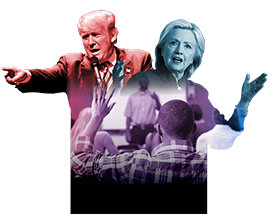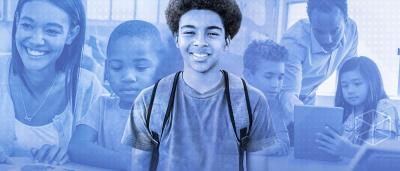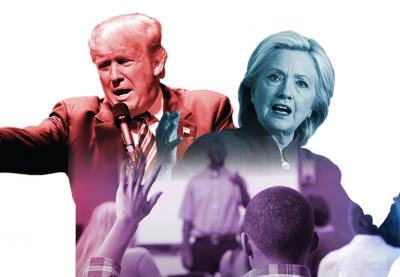In February 2016, the opening month of presidential primary season, I visited a public high school in New York City to teach a lesson about political polarization in the United States. The students were all black and Latino and had grown up in Manhattan, a borough that voted 84 percent for Barack Obama in 2012.
I began by explaining that I was going to give them one word and ask them to write down all the words that came to mind when they heard that word. Then, I would give them a second word and they would do the same thing. The first word was Republican, and the second word was Democrat.
We then made a class list of the words they had chosen. Students identified many that one might expect. Republican lists often included conservative, capitalism and Donald Trump. Democrat lists included blue, Barack Obama and middle class. When asked what they noticed about the lists, students immediately recognized that there was a difference in tone. The Democrat lists also included positive words like honest, caring and supportive. The Republican lists, on the other hand, included labels like greedy and heartless.
The activity demonstrates what political scientists term “affective polarization.” That is, as our country becomes politically polarized, one effect is that people increasingly distrust—or disdain—those who identify as members of political parties to which they, themselves, do not belong. This trend applies to both sides of the primary partisan divide in the United States. A 2014 Pew Research Center survey found that 38 percent of Democrats and 43 percent of Republicans have a “very unfavorable” view of the other party. These numbers reflect a significant increase since 1994, when 16 percent of Democrats and 17 percent of Republicans reported a “very unfavorable” view.
The students at the Manhattan high school I visited are growing up in what my colleague and collaborator Diana Hess and I have labeled a “like-minded” school. (We define schools as like-minded if 80 percent of the students reported either solidly liberal views or solidly conservative views on a survey of eight political issues.)
We found that students who grow up in politically homogeneous communities (be they liberal or conservative) develop some positive civic characteristics. While in high school, they score significantly higher on a measure of civic engagement than their peers in politically diverse schools. After high school, they are more likely to pay attention to elections, and they are more likely to report that their families and friends think it is important to keep up with the news. In our study, they also voted in midterm and general elections at much higher rates than other young people.
But political science research also shows that people who have strong ideological views (solid liberals and solid conservatives) are also more likely to believe that the other side has no good views (political intolerance), dismiss credible information that does not comport with their views (confirmation bias), and believe that politics is a battle between “the good team” and “the bad team” (affective polarization).
As anti-bias educators, we should be concerned about the negative effects of polarization. Democracy erodes when citizens do not enter the public sphere with a spirit of what Professor of Government Danielle Allen at Harvard University labels “political friendship.” In Talking to Strangers: Anxieties of Citizenship Since Brown v. Board of Education, Allen writes that living in a democracy requires citizens to recognize that they will lose at times, but those losses are tolerable if we trust that our rivals will govern with attention to the common good.
Civic Education in an Era of Polarization
For the past 25 years, the United States has been experiencing increasing political polarization; this is the only political context that young people today have experienced. Polarization also shows no signs of abating. Given this reality, how should teachers prepare young people for living in a democracy?
Understanding the root causes of both polarization and income inequality is essential for understanding contemporary American politics.
Teach about polarization
Political polarization refers to the division of political parties along ideological lines and movement away from the political center. It is important for young people to understand that polarization happens periodically, but it is not a constant feature of American democracy.
The current period of polarization began when the centrist “purple” parties of the 1950s and 1960s began to ideologically realign and transform into what many people now consider a liberal Democratic Party and the conservative Republican Party. This “sorting” of the parties began in the 1960s and was complete by the early 1990s.
Polarization has emerged from a confluence of trends. In addition to the ideological sorting of the parties, they include historically high levels of income inequality, increases in immigration, and the appearance of 24-hour news coverage and the internet.
Teaching students what polarization is and what social forces contribute to it will better prepare them for the democracy they will inherit.
Teach about ideology
To understand polarization, young people need to learn both what ideology is and the competing values within various ideological positions. In its most simplified sense, political ideology answers three questions: What is a good society? How should we get it? What are the causes of the problems we see today?
Liberals and conservatives within the American context generally agree that democracy is the best way to govern and that we should achieve it through the democratic structures outlined in state and federal constitutions. However, they tend to disagree about what a good democracy looks like. That is, they disagree about such foundational questions as:
- How much (if at all) should the federal government regulate the economy?
- How much political power should be given to states versus the federal government?
- To what extent (if at all) should the government provide a social safety net for the most vulnerable members of society?
- Which values should be given priority when they come into conflict (such as when civil liberties are in tension with national security)?
Helping students understand how and why liberals and conservatives have different political commitments and values—and how those commitments and values evolved—is essential for understanding our partisan divides.
Teach about income inequality
In Polarized America, authors Nolan McCarty, Keith T. Poole and Howard Rosenthal show that, in the past 150 years, the United States has experienced two periods of extreme polarization: our current one and the years leading up to World War I. Both periods were also marked by extreme income inequality. The authors find that polarization and income inequality rise and fall with near perfect correlation, and they conclude that these two forces “dance” together in such a way that each exacerbates the other.
These two forces get linked, in part, because as income inequality rises, our ideological differences make it nearly impossible for people to agree on policies that might reduce the gap between the “1 percent” and the “99 percent.” 
Liberals are likely to conclude that extreme income inequality is the result of the government not doing enough to regulate the behaviors of corporations and that policies like increasing the minimum wage or raising taxes on the very rich would improve the lives of middle- and low-income earners. Conservatives, on the other hand, are likely to conclude that government regulation of the economy inhibits job growth and causes more inequality. In this view, less regulation, not more, is the solution.
Income inequality is a major social problem, in part because it erodes faith in the democratic system. Understanding the root causes of both polarization and income inequality is essential for understanding contemporary American politics. If young people do not understand these trends, they will be left to interpret the world through the divisive behaviors of affective polarization.
Undermining Affective Polarization in the Classroom
But examples of how teachers can approach these issues do exist. Ayo Magwood, who teaches 10th-grade U.S. history at Maret School, a private school in Washington, D.C., artfully waded into these waters with her final unit, “Inequality and the Dispossessed in Black and White.”
According to Magwood, the vast majority of students at Maret come from liberal families, and during the 2015-16 school year, she often heard students refer to Donald Trump and his supporters as “idiots.” This response did not sit well with Magwood, who aims to push students to understand what motivates people who think differently than they do. For this final unit, she decided to challenge students to investigate why people—particularly low-income white people—were drawn to Trump. Further, she noted that there was considerable overlap between the economic experiences of low-income white people and those of the poor black communities in nearby Baltimore that experienced civic unrest the previous summer.
Magwood’s unit set up a comparison between these two marginalized groups: In what ways were their experiences similar and how were they different? Why did one group turn to Trump and the other to movements like Black Lives Matter?
Students were assigned to investigate one of the two groups. Each group read and discussed a packet of articles Magwood had curated to teach students about economic trends from the 1970s through today. Issues included the decline of unions, the loss of manufacturing jobs and the free-trade movement. Students also learned about how structural racism shapes urban policies that, to borrow from Ta-Nehisi Coates, “pillage” black communities. Finally, they read about evidence of racial resentment motivating some Trump supporters.
The unit culminated in an evening discussion to which families were invited. Even though the families had received some of the same classroom materials, Magwood says some of her students “were shocked at how one-sided and judgmental a few of the parents were.” While the students had come to see that there were real economic problems motivating both poor white and poor black communities, a handful of parents had a difficult time moving beyond Trump’s inflammatory rhetoric to get at the issues.
Many of Magwood’s students reported that the unit was their favorite part of the course. In her view, Trump’s candidacy created a teachable moment that hooked students into learning about the history of economic inequality. Through that investigation, Magwood highlighted the role that competing ideologies play in responding to inequality and economic policy.
In the end, students moved beyond affective polarization and thinking, “They’re idiots” to the more reflective position of, “I understand why they feel this way, but I disagree.” Perhaps most important, they saw polarization, income inequality and racism as social problems we all share.
How Did We Get Here?
The political climate in the United States did not become polarized overnight. Remind students of these key moments in history and how they helped ideologically “sort” the Democratic and Republican parties.
1950s Both the Republican Party and Democratic Party were ideologically moderate parties. Democrats are more ideologically mixed because their party is a coalition between Northern liberals and Southern conservatives known as “Dixiecrats.”
1960s The ideological sorting of the parties begins when the Democratic coalition weakens over federal desegregation efforts in the South. The split becomes irreparable after the passage of the Voting Rights Act of 1965.
1970s The defection of Dixiecrats to the Republican Party, which began in the mid-1960s, begins to change the character of both parties, creating a more solidly liberal Democratic Party and a more solidly conservative Republican Party.
1980s Republican Newt Gingrich, who became a junior member of the House of Representatives in 1979, slowly changes the Republican strategy to rally his party behind a unified message with the goal of taking back control of the House. (Republicans had been in the minority since 1955).
1990s In 1994 the Republicans win the majority in the House for the first time in 40 years, in large part due to their “Contract With America,” a policy statement that detailed the party’s conservative legislative agenda. Newt Gingrich is elected Speaker of the House. Both parties are now “ideologically sorted,” and the effects of polarization become more evident and widespread.

